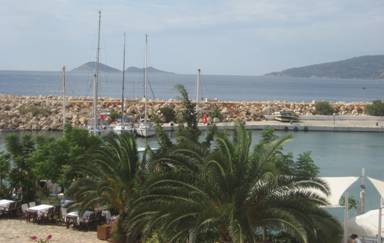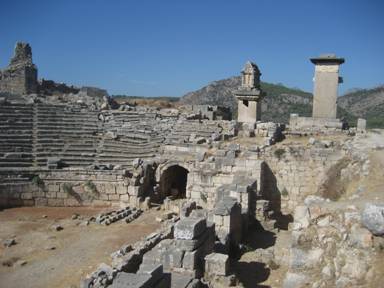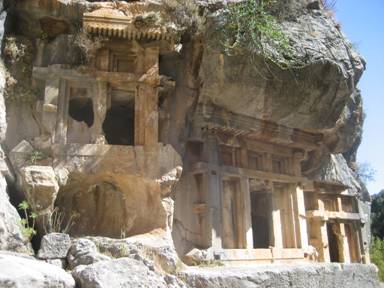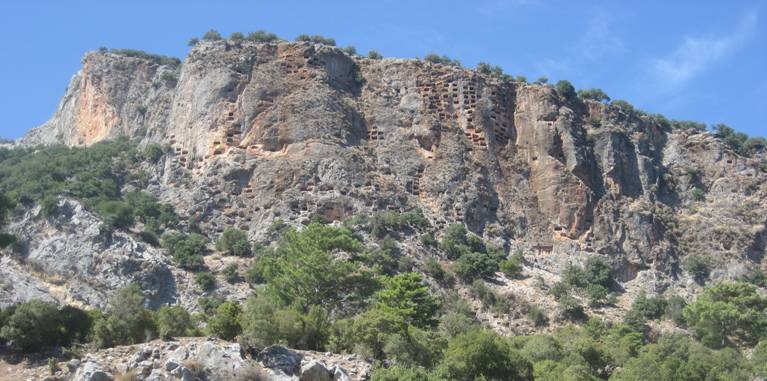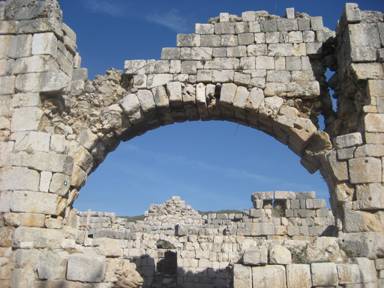Kalkan for the Lycian ruins

|
The day we lost “Panda Cub”! We’ve been towing our dinghy (christened “Panda Cub” earlier this year by an old friend) all summer with only one drama in very big seas and a huge gust of wind, so the sail out of Gocek in flat seas and little wind didn’t raise any concerns. When the winds picked up a bit and I spent half an hour or so unsuccessfully trying to goosewing (setting main and fore-sails on opposite sides of the boat) the seas got a bit lumpy and one of the lumps must have carried away our poor tender. Recovering the rope showed that the rings it was tied to by had been torn out. We motored back over the course it could have taken, but gave up looking after 40 mins, our limit before we’d be too late into harbour. Soon after we got back on course Lindsay spotted her, upside down & being blown downwind slowly, probably only a few hundred yards from where we were when we started looking. The waters we were in are called the Seven Capes and are notorious for big seas, so we should have been on our guard I guess, but no harm done, in fact some good, as our teamwork in searching & recovering was pretty good we think!
We arrived outside the little harbour of Kalkan in the same high, gusty winds, but luckily inside was calm enough as we squeezed in to the last space on one side between two charter boats. We were too weary to do much that evening after our eventful day, so stayed aboard and admired the pretty, upmarket town all lit up and humming with trendy bars and restaurants climbing up the opposite side of the harbour.
The main reason for coming to this spot was to visit some of the outstanding Lycian ruins in the area, so we hired a car in the morning and drove first to the ancient city of Xanthos, a Unesco World Heritage site and the most important city in the old Lycian League. It is most famous for being the city which twice in its history – once in the 6th and once in the 1st century BC, chose to die to the last man, woman and child rather than surrender to the enemy after a siege. It has 2 impressive pillar tombs of massive proportions, one of which had a lovely carved frieze around the top before it was removed by a Victorian explorer in 1842 along with other treasures from the site. It, and the beautiful Neried Monument, are now in the British Museum which is rather an embarrassment! We wandered around the extensive necropolis hillside at the edge of the city and marvelled at the effort that must have gone into carving out these huge rock tombs and the cask-like sarcophagi which litter the area.
We then drove up into the mountains along a challenging dirt track to another Lycian city called Pinara which is a more peaceful spot as it does not feature on so many tourist itineraries. As you approach, you see the massive cliff under which the city was founded (maybe around the 4th century BC). It is riddled with tomb holes so that it has been dubbed the “Swiss Cheese” cliff and you can’t imagine how they managed to carve out the higher tombs at all. We climbed and explored around the tombs and amongst the ruins of the old acropolis, temple etc and the whole place in its beautiful setting among aromatic pine trees and herbs with wonderful views was a high point of the day.
We then drove up the meandering valley of the former Xanthos river to the Saklikent Gorge which would be a worthwhile visit if it hadn’t been completely overrun with tourists and all the accompanying commercial exploitation which the Turks seem particularly good at. It was interesting to see just what a volume of water still explodes out of holes in the rock from the mountains above even at the end of the hot dry summer season. Apparently it is much too dangerous to go there in the winter months.
Our final stop of the day was at the joint archaeological and beach site of Patara which we had sailed past the previous day. The ruins here of the principal Lycian port are still being uncovered from the sand dunes and we particularly admired the massive ancient baths building with its intact (though goodness knows how) arch, and the theatre with its views across to the old harbour which is now well inland behind the sand dunes. Apparently the beach here with its very fine white sand, ranks as one of the longest continual strands in the Mediterranean and is another turtle nesting site.
All in all it was one of those satisfying days of exploration when we feel privileged to be able to learn more of a region’s history and it makes the travelling particularly worthwhile.
|
